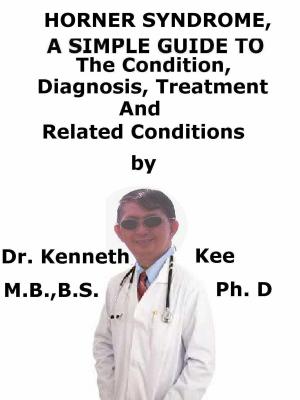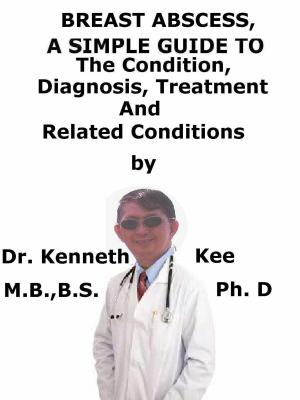Infant Jaundice, A Simple Guide To The Condition, Diagnosis, Treatment And Related Conditions
Nonfiction, Health & Well Being, Medical, Specialties, Internal Medicine, Hematology, Health| Author: | Kenneth Kee | ISBN: | 9781370194254 |
| Publisher: | Kenneth Kee | Publication: | May 25, 2017 |
| Imprint: | Smashwords Edition | Language: | English |
| Author: | Kenneth Kee |
| ISBN: | 9781370194254 |
| Publisher: | Kenneth Kee |
| Publication: | May 25, 2017 |
| Imprint: | Smashwords Edition |
| Language: | English |
Infant jaundice happens when a baby has a high level of bilirubin in the blood.
Bilirubin is the yellow substance that the body produces when it replaces old red blood cells.
The liver helps to break down the substance so it can be eliminated from the body in the stool.
High levels of bilirubin (serum bilirubin levels from 17-25 mg/dL (294-430 µmol/L) make the baby's skin and whites of the eyes look yellow.
The medical term for jaundice in babies is infant jaundice
Jaundice is a frequent and normally harmless disorder in newborn babies that produces yellowing of the skin and the whites of the eyes - physiological.
It only becomes harmful when too high bilirubin damages the brain and the hearing organ - pathological.
It is evaluated that 60% babies develop jaundice, such as 80% babies born prematurely (babies born before the 37th week of pregnancy).
Only around 5% babies have a blood bilirubin level high enough to require treatment.
Serious newborn jaundice may happen if the baby has a disorder that raises the number of red blood cells that require to be replaced in the body, such as:
Abnormal blood cell shapes
1. Blood type mismatch between the mother and baby
2. Bleeding underneath the scalp (cephalohematoma) caused by a difficult delivery
3. Higher levels of red blood cells, which is more frequent in small-for-gestational-age babies and some twins
4. Infection
5. Lack (deficiency) of certain important proteins, called enzymes
Disorders that make it more difficult for the baby's body to eliminate bilirubin may also result in more severe jaundice, such as:
1. Certain medicines
2. Infections present at birth, such as rubella, syphilis, and others
3. Diseases that affect the liver or biliary tract, such as cystic fibrosis or hepatitis
4. Low oxygen level (hypoxia)
5. Infections (such as sepsis)
6. Many different genetic or inherited disorders
Babies who are born too early (premature) tend more likely to form jaundice than full-term babies.
Jaundice produces a yellow color of the skin that begins on the face and then spreads down to the chest, belly area, legs, and soles of the feet.
Other symptoms are:
1. Dark, yellow urine – Normally colorless
2. Pale-colored stools
3. Tiredness and poor appetite
Hospitals use probes that can evaluate the bilirubin level just by touching the skin.
High readings require to be confirmed with blood tests
Treatment is not required most of the time as the symptoms normally pass within 10 to 14 days, even though symptoms can persist longer in a minority of cases.
Treatment is normally only advised if tests reveal a baby has very high levels of bilirubin in their blood because there is a small risk the bilirubin could pass into the brain and cause brain damage.
When treatment is required, the type will be dependent on:
1. The baby's bilirubin level
2. How fast the level has been rising
3. Whether the baby was born early (babies born early are more likely to be treated at lower bilirubin levels)
4. How old the baby is
5. A baby will require treatment if the bilirubin level is too high or is rising too quickly.
6. A baby with jaundice requires to be kept well hydrated with breast milk or formula.
7. Feed the baby often (up to 12 times a day) to encourage frequent bowel movements.
These help eliminate bilirubin through the stools
Treatment is by:
Phototherapy or light therapy- can be done in hospital or at home with eye covering patches and diapers
Intravenous immune globulin IVIG therapy - mainly for blood incompatibility
Exchange blood transfusion - a more dangerous procedure for serious cases of infant jaundice
New treatment consists of inhibition of bilirubin production through obstruction of heme oxygenase.
TABLE OF CONTENT
Introduction
Chapter 1 Infant Jaundice
Chapter 2 Causes
Chapter 3 Symptoms
Chapter 4 Diagnosis
Chapter 5 Treatment
Chapter 6 Prognosis
Chapter 7 Kernicterus
Chapter 8 G6PD Deficiency
Epilogue
Infant jaundice happens when a baby has a high level of bilirubin in the blood.
Bilirubin is the yellow substance that the body produces when it replaces old red blood cells.
The liver helps to break down the substance so it can be eliminated from the body in the stool.
High levels of bilirubin (serum bilirubin levels from 17-25 mg/dL (294-430 µmol/L) make the baby's skin and whites of the eyes look yellow.
The medical term for jaundice in babies is infant jaundice
Jaundice is a frequent and normally harmless disorder in newborn babies that produces yellowing of the skin and the whites of the eyes - physiological.
It only becomes harmful when too high bilirubin damages the brain and the hearing organ - pathological.
It is evaluated that 60% babies develop jaundice, such as 80% babies born prematurely (babies born before the 37th week of pregnancy).
Only around 5% babies have a blood bilirubin level high enough to require treatment.
Serious newborn jaundice may happen if the baby has a disorder that raises the number of red blood cells that require to be replaced in the body, such as:
Abnormal blood cell shapes
1. Blood type mismatch between the mother and baby
2. Bleeding underneath the scalp (cephalohematoma) caused by a difficult delivery
3. Higher levels of red blood cells, which is more frequent in small-for-gestational-age babies and some twins
4. Infection
5. Lack (deficiency) of certain important proteins, called enzymes
Disorders that make it more difficult for the baby's body to eliminate bilirubin may also result in more severe jaundice, such as:
1. Certain medicines
2. Infections present at birth, such as rubella, syphilis, and others
3. Diseases that affect the liver or biliary tract, such as cystic fibrosis or hepatitis
4. Low oxygen level (hypoxia)
5. Infections (such as sepsis)
6. Many different genetic or inherited disorders
Babies who are born too early (premature) tend more likely to form jaundice than full-term babies.
Jaundice produces a yellow color of the skin that begins on the face and then spreads down to the chest, belly area, legs, and soles of the feet.
Other symptoms are:
1. Dark, yellow urine – Normally colorless
2. Pale-colored stools
3. Tiredness and poor appetite
Hospitals use probes that can evaluate the bilirubin level just by touching the skin.
High readings require to be confirmed with blood tests
Treatment is not required most of the time as the symptoms normally pass within 10 to 14 days, even though symptoms can persist longer in a minority of cases.
Treatment is normally only advised if tests reveal a baby has very high levels of bilirubin in their blood because there is a small risk the bilirubin could pass into the brain and cause brain damage.
When treatment is required, the type will be dependent on:
1. The baby's bilirubin level
2. How fast the level has been rising
3. Whether the baby was born early (babies born early are more likely to be treated at lower bilirubin levels)
4. How old the baby is
5. A baby will require treatment if the bilirubin level is too high or is rising too quickly.
6. A baby with jaundice requires to be kept well hydrated with breast milk or formula.
7. Feed the baby often (up to 12 times a day) to encourage frequent bowel movements.
These help eliminate bilirubin through the stools
Treatment is by:
Phototherapy or light therapy- can be done in hospital or at home with eye covering patches and diapers
Intravenous immune globulin IVIG therapy - mainly for blood incompatibility
Exchange blood transfusion - a more dangerous procedure for serious cases of infant jaundice
New treatment consists of inhibition of bilirubin production through obstruction of heme oxygenase.
TABLE OF CONTENT
Introduction
Chapter 1 Infant Jaundice
Chapter 2 Causes
Chapter 3 Symptoms
Chapter 4 Diagnosis
Chapter 5 Treatment
Chapter 6 Prognosis
Chapter 7 Kernicterus
Chapter 8 G6PD Deficiency
Epilogue















